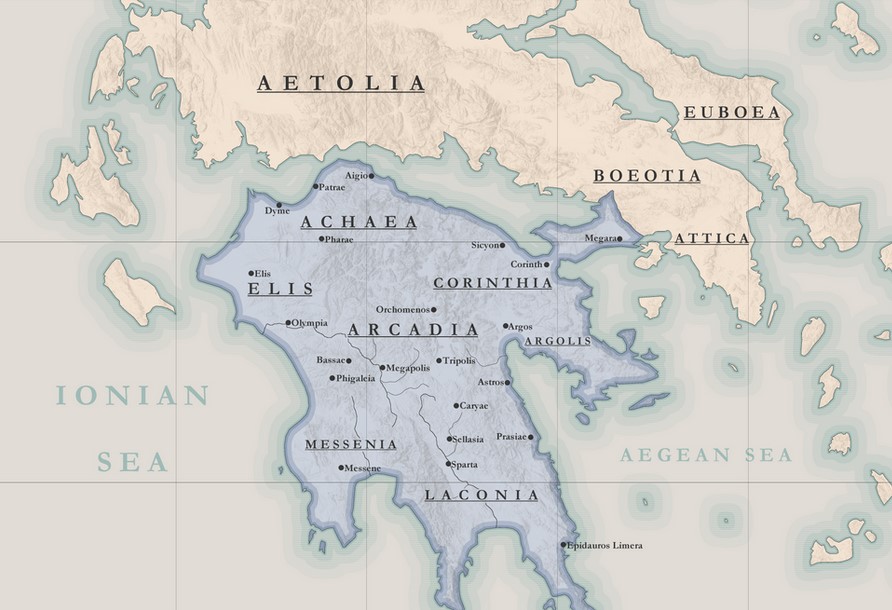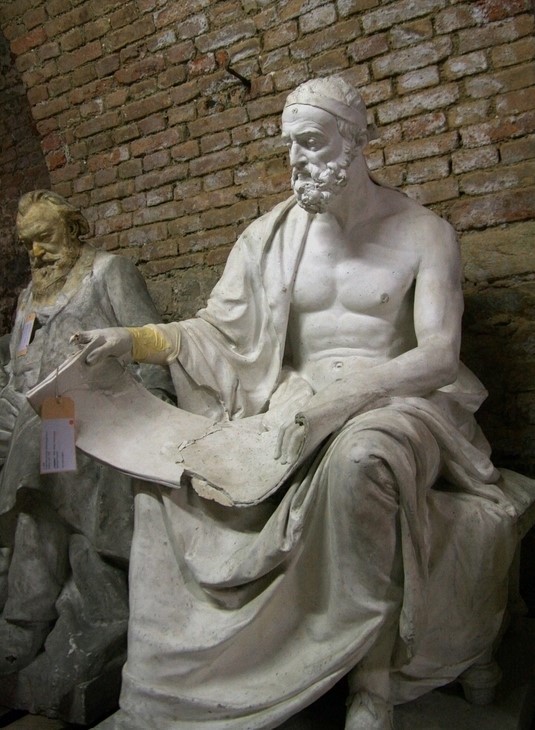The Achaean League: A Quest for Autonomy in Ancient Greece
The Achaean League was a confederation of city-states in the region of Achaea in the northern Peloponnese. In the Homeric and Roman periods, Achaeans referred broadly to all Greeks, but in historical times, the term described the inhabitants of this specific region. Two distinct areas bore the name Achaea: Achaea Phthiotis in Thessaly and the Achaea of the Peloponnesus, the latter being the focus of the League.

Fresco of an ancient Macedonian soldier bearing a thyreos shield. Archeological museum in Istanbul, c.250 BCE
Formation and Early Structure
An early Achaean League existed as early as the 4th century BCE, but a more significant confederation formed between 280 and 270 BCE. This second league united ten closely related city-states (including Patrae, Dyme, and Egio) under a federal system, emphasizing shared heritage and language. Initially, leadership was held by two annual magistrates, but by 255 BCE, a single general, or strategos, assumed both political and military responsibilities, with Margo of Ceryneia as the first.
Political and Territorial Growth
For its first two decades, the League remained inconspicuous, aiming to preserve its autonomy amidst the power struggles of neighboring states. It entered the historical spotlight in 251 BCE when Aratus of Sicyon joined his city to the League. Though Sicyon was less significant than the original ten cities, its inclusion posed the challenge of integrating local autonomy into a cohesive federal system. This integration became vital as the League sought to expand in a Peloponnesian landscape dominated by Macedonian-backed tyrants and the remnants of Spartan hegemony.
Anti-Macedonian and Anti-Spartan Stance
Under Aratus, the League adopted an anti-Macedonian and anti-Spartan policy, seeking alliances with powers such as Egypt’s Ptolemaic dynasty. Notable successes included the annexation of Corinth (243 BCE), a strategic city critical to controlling the Peloponnesus. The League faced significant challenges, including invasions by the Aetolian League, another Greek confederation. Despite setbacks, the League expanded its territory and population, incorporating major Arcadian cities like Megalopolis and Mantinea by 235 BCE.
Cleomenic War and Alliance with Macedonia
The rise of Cleomenes III of Sparta in 227 BCE initiated a period of intense conflict. Cleomenes implemented sweeping social and military reforms, strengthening Sparta and challenging the Achaean League. After initial defeats and isolation, Aratus, the League's strategist, sought an alliance with Macedonia. Though controversial, this alliance with Antigonus Doson helped secure victory against Cleomenes at Sellasia (222 BCE). However, the alliance came at the cost of Achaean autonomy, with Macedonian garrisons stationed in key cities like Corinth.
The Federal Experiment and its Legacy
The Achaean League, especially in its collaboration with Macedonia, represented an innovative political model blending republican and monarchical elements. It united various city-states and regions under a shared federal structure (koinon), balancing local autonomy with collective decision-making. Despite its achievements, the League struggled to maintain independence from Macedonia, highlighting the tensions between small-scale liberty and large-scale unity in ancient Greece.
The Social War (219–217 BCE)
Philip V engaged in the Social War, leading campaigns in Aetolia and Acarnania, and extending his reach into the Peloponnesus. Initial victories included the capture of key territories like Psofida and Trifylia. However, tensions arose between Philip and Achaean leaders over territorial claims, financial burdens, and the imposition of Philip's chosen candidate, Eperatus, as Achaean strategos.
Despite some successes, including the sack of Thermos and victories over the Spartans, internal divisions and economic strains weakened the Achaean League. The war ended in 217 with a treaty based on the uti possidetis principle, preserving territorial gains but increasing Macedonian dominance.
Growing Macedonian Influence
The League's reliance on Macedonia caused dissatisfaction. While Philip achieved strategic expansions, including Trifylia and Tebe Ftiotica, Achaean contributions were overshadowed by financial exhaustion and internal political disputes. Notably, Achaean leader Aratus died in 214, possibly poisoned by Philip, highlighting their deteriorating relations.
Roman Interference and the Decline of Macedonian Influence
By 211 BCE, Rome's growing interest in Greek affairs materialized through alliances with Aetolia and Sparta, marking a turning point in regional dynamics. The Romans' naval superiority and strategic acumen challenged Philip's influence. This shift culminated in the Achaean League's pivot toward neutrality and eventual alignment with Rome.
In 200 BCE, as tensions with Rome escalated, Philip struggled to maintain his hold over the Peloponnesus. The Roman campaign in 198, led by T. Quinctius Flamininus, decisively weakened Macedonian authority, prompting the Achaean League to sever ties with Philip and join Rome. The fall of Corinth symbolized the end of Achaean dependence on Macedonia and the beginning of Roman dominance in Greek politics.

Philopemene wounded - Louvre Museum
The Rise of Philopoemen
During this period, Achaean statesman Philopoemen emerged as a transformative figure. He reformed the League’s military, creating a competent army capable of countering regional threats like Sparta. His leadership brought victories, such as the defeat of Spartan tyrant Machanidas at Mantinea in 207 BCE, enhancing the League's standing and independence.

Territory of the Achaean League in 200 BCE (excluding Boeotia).
Now, we study the interactions and complex relationships between the Achaean League, Rome, and other Greek powers during the Hellenistic period, with a particular focus on the Achaean League's political and military maneuvers as it navigated the dominance of Rome.
- Early Alliance with Rome (197 BCE):
- The Achaean League contributed to Rome's campaigns against Macedonia, particularly during the decisive Battle of Cynoscephalae (197 BCE), which ended Macedonian dominance.
- Post-victory, Rome granted Corinth, Heraea, and Triphylia to the Achaeans, reinforcing their belief in preserving sovereignty alongside their Roman alliance.
- Roman Proclamation of Greek Freedom (196 BCE):
- At the Isthmian Games, Rome declared the "freedom" of Greek states while maintaining military garrisons in key fortresses, including Acrocorinth.
- The Achaeans viewed this as a triumph, aligning their goals with Roman interests.
- War with Sparta (195 BCE):
- A campaign against Nabis of Sparta, supported by Achaean and Roman forces, concluded with Sparta’s surrender. The Achaeans gained control over Argos and other cities in Laconia.
- Despite Spartan resistance, the League emerged stronger, though increasingly reliant on Roman support.
- Continued Expansion under Roman Oversight (192-190 BCE):
- During the war between Rome and Antiochus III of Syria, the League supported Rome, contributing forces to battles at Chalcis, Pergamon, and Magnesia.
- Rome facilitated the unification of Messenia and Elis with the League, achieving unprecedented territorial consolidation in the Peloponnesus.
- The Growing Shadow of Rome:
- The League's expansion was accompanied by implicit Roman control, limiting its autonomy.
- Political divisions emerged between factions favoring strict Roman alignment (led by Callicrates) and those advocating for a more independent policy (Filopemen and Licortas).
- Internal Conflicts and Decline (185-170 BCE):
- Under Filopemen, Sparta was forcibly integrated into the League, its traditional laws abolished. This led to tensions with Rome, though the League retained considerable freedom.
- Disputes between pro-Roman and anti-Roman factions weakened the League. Pro-Roman leaders accused opponents of subversion, leading to mass deportations to Rome, including the historian Polybius.
- Final Years of the League’s Autonomy (168-146 BCE):
- After the Roman victory at Pydna (168 BCE), Macedonia was dismantled, and the Achaean League gained minor territorial additions.
- However, Rome increasingly dictated the League's policies, culminating in reduced autonomy and eventual subjugation.

Achaean League in 192 BCE

Models made of gypsum of statues, reliefs etc. from the time of Historicism and Art Nouveau (late 19th and early 20th century) for buildings at Ringstraße in Vienna, Austria, stored in the former wine cellar of Hofburg Palace

Achaean League in 150 BCE
The Achaean League's trajectory reflects the broader theme of Greek city-states struggling to maintain independence amidst the rise of Roman hegemony. Initially, the League sought to leverage alliances with Rome for territorial and political gain, successfully uniting much of the Peloponnesus. However, reliance on Roman military and diplomatic support increasingly eroded their sovereignty. Political divisions within the League further exacerbated its decline, as Rome used internal conflicts to assert control.
The tensions and ultimate downfall of the Achaean League in the 2nd century BCE and rising Roman influence, highlight political and social dynamics within Greece and the complex interplay between the Achaean League, Sparta, and Rome.
The Achaean League's demise symbolized the transition of Greece from fragmented independence to integration under Roman control. While marked by tragedy, this period also paved the way for Greece’s cultural and political adaptation to a new global order.
- Anti-Roman Sentiments Among the Achaeans:
Despite temporary suppression, anti-Roman sentiments persisted within the Achaean League. Political disputes and social unrest in Greece were exacerbated by Roman interventions. Each decision by the Roman Senate created new conflicts, undermining internal unity. - Sparta’s Conflicts and Roman Mediation:
The dispute between the Achaean League and Sparta became emblematic of broader issues. Roman arbitration often favored factional splits, leading to increased resentment. Efforts to appease Rome, such as exiling Spartan leaders, failed to stabilize the region. - Social and Economic Underpinnings:
Rome’s support for wealthy Greek elites alienated the lower classes, intensifying class struggles. Economic crises further sharpened divisions, blending social grievances with political resistance to Roman domination. - Military Resistance and Rome’s Retaliation:
Achaean military efforts under leaders like Critolaos and Dieo culminated in catastrophic defeats. These leaders, while inspiring the masses, underestimated Roman military power, leading to disastrous battles such as the one at Scarfia. Rome’s eventual intervention by consul Mummius decisively crushed Achaean resistance. - The Fall of Corinth and Aftermath:
Corinth's destruction in 146 BCE marked the definitive end of the Achaean League. Roman forces, led by Mummius, burned the city and reorganized Greek governance. Popular rule was replaced by oligarchic systems favoring landowners, ensuring stability under Roman oversight. - Legacy and Roman Order:
Despite initial devastation, Roman rule brought long-term stability and economic revitalization to Greece. Figures like the historian Polybius, an Achaean who had witnessed Rome’s system firsthand, helped reconcile Greeks to Roman governance. His writings preserve the legacy of the League, offering insights into its strengths and weaknesses.
The Constitution of the Achaean League
The Achaean League was a federation of cities with a dual system of citizenship: each citizen belonged to their city (municipal citizenship) and the federation (federal citizenship). When a city joined the League, citizenship was extended to its residents, and an agreement defined mutual rights and obligations. This agreement was perpetual and binding, preventing unilateral withdrawal by either party. Departure from the League required mutual consent; otherwise, it was deemed rebellion and subject to suppression.
Governance Structure:
- Division of Authority:
- Foreign policy (war, peace, diplomacy) and military matters were under the League’s jurisdiction.
- Local governance (private law) remained with individual cities.
- Judicial power was divided: federal courts handled federal offenses, and city courts dealt with municipal crimes.
- Standardized currency, weights, and measures applied across the League.
- Military and Financial Obligations:
- The League determined the quotas for military conscription and taxes for each city, which then apportioned these among its citizens.
Assemblies and Decision-Making:
- Federal Assemblies:
- Synodos (Ordinary Assembly): Smaller, convened regularly, handled routine governance and decisions based on supreme assembly resolutions.
- Synkletos (Extraordinary Assembly): Larger, included all Achaeans over 30, convened for critical matters like declaring war, treaties, or admitting new cities.
- Voting:
- Voting in assemblies was typically by city, not by individual citizens.
- Magistrates were elected in a separate assembly, where individuals voted individually.
- Legislative and Executive Powers:
- Laws were drafted by a specific magistracy.
- Decrees issued by assemblies were binding.
Federal Leadership:
- Strategos (Commander):
- The highest official, held military, political, and administrative authority.
- Presided over assemblies, executed decisions, and could act independently in emergencies, subject to later approval.
- In grave situations, could assume dictatorial powers as "autocrator," although sometimes this authority was delegated to another.
- Other Officials:
- Hipparch (Cavalry Commander): Second in rank after the strategos.
- Navarch (Admiral): Oversaw the navy, though naval power was limited.
- General Secretary and Treasurer: Managed administration and finances.
- Election and Accountability:
- Officials were elected annually, with no restrictions on wealth or birth.
- Reelection to certain positions, like strategos, was sometimes limited by tradition.
- Outgoing officials had to present an account of their tenure and could be judged by the assembly or courts.
This constitutional framework reflected a balance between local autonomy and federal authority, ensuring unity while respecting the individual character of each city within the Achaean League.
Last update: December 2, 2024
Go to definitions: A | B | C | D | E | F | G | H | I | J | K | L | M | N | O | P | Q | R | S | T | U | V | W | X | Y | Z
 DONATE
DONATE 